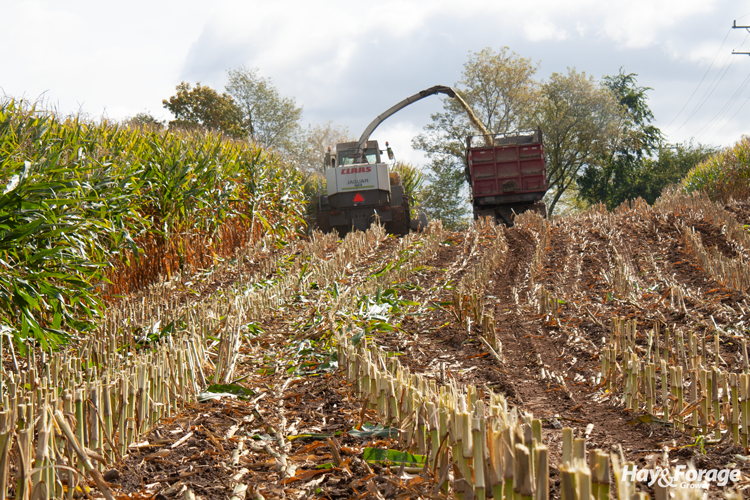
Consumers have a way of changing agricultural trends. For example, in the grocery store, more sustainable food products are often chosen if given a choice.
Dairy and beef cattle can also be thought of as consumers — but for forage growers. Dairy and beef cattle consumer preferences are also influencing agricultural trends, though in a slightly different way than humans. Changing dairy and beef cattle diet preferences are affecting growers’ cropping strategies.
More corn silage
Dairy herds across the U.S. and the world are continuously gaining in feed conversion efficiency. Herd management and genetics are impactful, but some of the realized gains can be attributed to improved nutrition programs such as more consistent diets and nutrient supply. Greater corn silage inclusion rates have contributed toward this consistency gain. With dairy and beef cattle consumer preferences changing, the forage component in dairy diets is now made up of more corn silage than ever before. This shift toward greater corn silage levels is having an effect on alfalfa feeding rates, and potentially shifting alfalfa grower goals and harvest strategies.

Alfalfa hay or haylage contributes to both structural and energy requirements in dairy diets. The importance of each corresponds to the relative amount of alfalfa in the diet. With more alfalfa, the energy value becomes more important. With less alfalfa, the structural fiber component becomes equally or more important than energy contribution. This latter case is where dairy diets are trending, along with greater corn silage feeding rates.
It’s now common for dairy diets to be made up with 22 to 30 pounds corn silage and 5 to 10 pounds alfalfa hay or haylage on a dry matter basis, with alfalfa inclusion rates between 10% and 20% of the total diet dry matter.
With higher dietary alfalfa feeding rates, I’ve advocated for shortening harvest intervals to boost energy value. This was because the energy value in alfalfa substantially influenced dry matter intake and milk production potential at higher feeding levels. Now, for the reasons discussed above, we’re pivoting in the opposite direction and entertaining discussions about stretching out alfalfa — in both cutting intervals and height. To arm your farm with more insight to help drive decision making with today’s diet trends, let’s compare and contrast two harvest strategies separated by about five days in harvest interval.
Harvest a bit later
Lengthening the interval between cuttings will boost yield, lower quality, and likely extend stand life. The relationship between alfalfa yield and quality is fairly well understood. For example, in a February 2017 Hay & Forage Grower article titled “Managing the yield and quality trade off,” we graphed out how yield and relative forage quality (RFQ) are inversely related. Learning from others and referencing a bit of research, I’ve come to believe that RFQ declines about 5 units and yield rises roughly 150 pounds of dry matter per acre for each added day alfalfa grows. Let’s work with these benchmarks in our comparison.
Table 1 details quality and yield ramifications associated with a five-day difference in cutting interval. Stretching out the cutting interval is projected to boost yield per acre by around 1.5 tons for the year, assuming four cuttings. We give up about 25 points in RFQ in this scenario.
With alfalfa fed at only 5 to 10 pounds of dry matter per cow, the projected milk production is only a half-pound different per cow per day. The 150 RFQ alfalfa will also contribute a bit more structural fiber relative to the 175 RFQ alfalfa, which can be valuable in higher corn silage diets with finely processed corn silage. Further, the positive impact on stand life associated with a longer cutting interval should be considered an added benefit above and beyond what we discuss here.
Alfalfa quality clearly has a lesser impact on dairy performance when fed at lower inclusion rates. Cows’ preference for consistency has driven alfalfa out of diets. With less alfalfa in diets, fewer acres are needed for hay or haylage; however, alfalfa will still be in the cropping rotation for most producers. Hence, for these alfalfa acres, gaining 1 to 2 tons in yield and giving alfalfa a few more growing days to contribute to root carbohydrate reserves are strong positives.
Dairy and beef cattle diet trends will continue to evolve, and your harvest strategies for growing forage can as well. If you’ve been pushing higher corn silage diets, consider the alfalfa concepts and projections covered here as you head into the next growing season.
This article appeared in the March 2024 issue of Hay & Forage Grower on page 9.
Not a subscriber? Click to get the print magazine.

